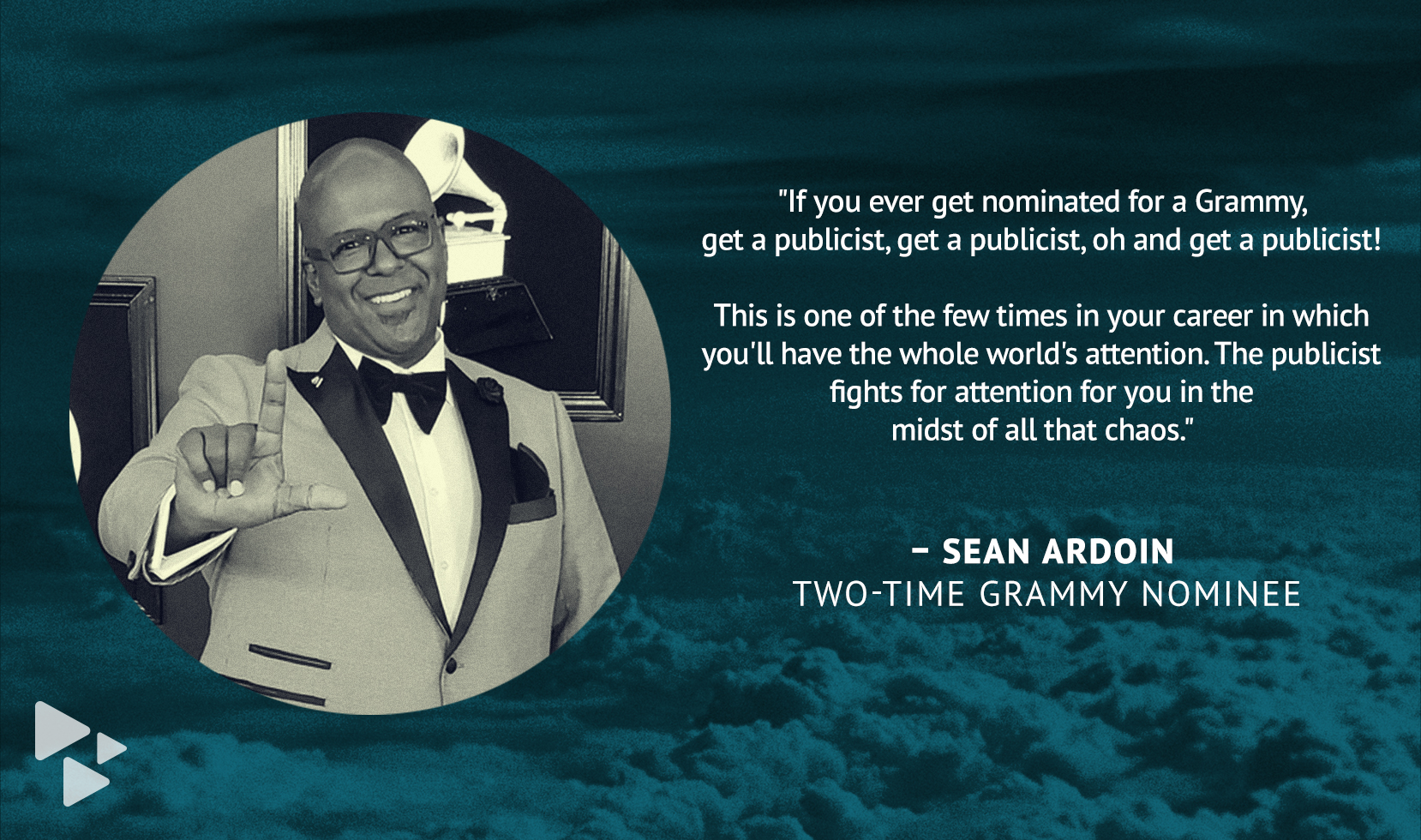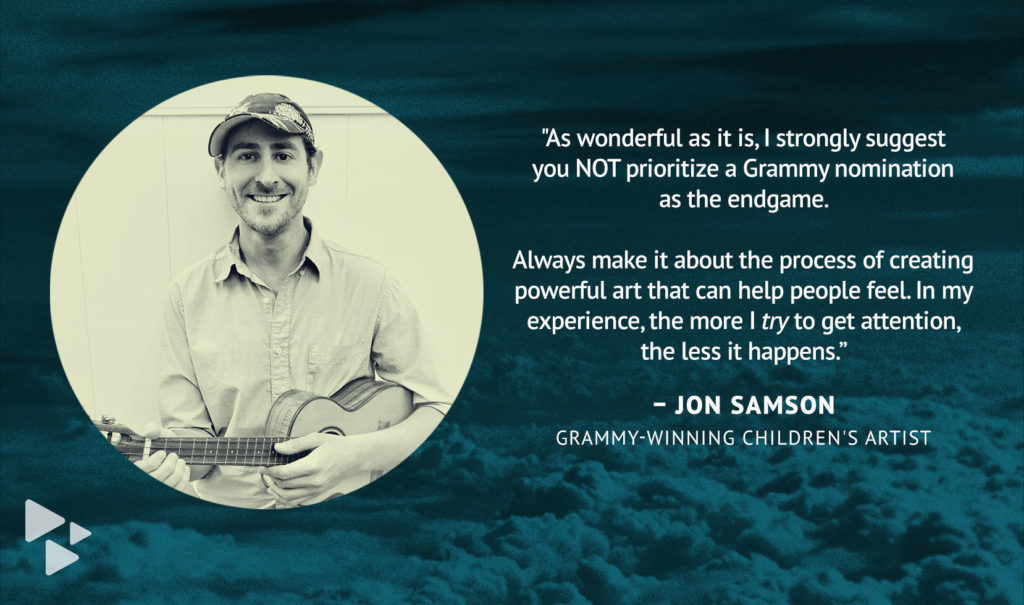
For most viewers and musicians, the Grammy awards are what we see on TV: big-time artists and much-hyped newcomers accepting trophies in a night dominated by the major players in the music industry. But here’s the big, not-so-well-kept secret: there are tons more awards across dozens of categories that aren’t shown on TV, many of which are won by indie artists. DIY musicians can be nominated for Grammys, and they can absolutely win. In the past few years, CD Baby artists have made huge showings at the ceremony in many categories.
But why are the Grammys important to indie musicians?
Why even concern yourself with being nominated or winning? For starters, it can be a huge step in an artist’s career. Even a nomination in your given genre can bring increased attention to your music. The phrase “Grammy-nominated/winning artist” is a huge selling point to stick on a press release or add to your bio. It lends legitimacy and carries a weight that still means something even in the modern music industry.
In the following article, we’ll provide a history of the Grammys, walk you through the whole process, from eligibility to nomination to voting, and hear from a few independent musicians whose careers got a big bump along the way. Read on to learn everything you wanted to know about the golden gramophone.
What are the Grammys?
As the last of the four major American entertainment awards to be founded, the Grammys are the baby of the EGOT (Emmy, Grammy, Oscar and Tony) family. These awards are given annually to outstanding achievements in their respective fields: the Academy Awards (Oscars), founded in 1929 to recognize achievements in film; the Tonys, founded in 1947 to recognize achievements in theater; the Emmys, founded in 1949 to recognize achievements in television; and finally the Grammys, founded in 1959 to recognize achievements in the music industry.
How did the Grammys start?
While the Grammys are mostly seen as a cog in the major label, big business music industry machine, the creation of the award itself has DIY foundations. During the planning for the Hollywood Walk of Fame project in the 1950s, it was decided that nominees from the music industry must have achieved sales of either one million records (songs) or 250,000 albums.
The music executives who were on the planning committee realized those stipulations would prevent many worthy candidates from induction. So, they did what any do-it-yourselfer would do: they created their own academy (the National Academy of Recording Arts and Sciences) and their own award, the Grammy. The first ceremony was held on May 4, 1959, with Henry Mancini receiving Album of the Year for The Music from Peter Gunn.
What are the eligibility requirements for Grammy submissions?
Like the other major American entertainment awards, the Grammys are completely open for all artists to have their music submitted. To be eligible for submission, a release only needs to meet three requirements:
- Release date: For the upcoming 2022 Grammy ceremony, submissions must have been distributed between September 1, 2020 and September 30, 2021.
- Length: To be considered for album submission, a recording must contain at least five different tracks with a total playing time of 15 minutes, or a total playing time of 30 minutes with no minimum track amount. Singles have no such requirements.
- Format: A submitted recording must be available for sale either in physical “brick and mortar” stores or online via digital download, or via a recognized streaming platform. A recording must meet the industry minimum standard 16-bit, 44.1 kHz rates. Each submitted song must have proper metadata credits (songwriters, producers, etc.) and International Standard Recording Codes (ISRCs) for each track.
- Original material: Starting with the 2023 Grammys, an album must contain greater than 75 percent of newly recorded (within five years of the release date), recordings that have not been released prior. Currently the rule is 50 percent.
Are other credited personnel also eligible?
Yes! For the 2022 Grammy ceremony and all ceremonies in the future, all credited artists (including featured artists), songwriters of new material, producers, recording engineers, mixers and mastering engineers are eligible to be nominated and win, at least in the Album Of The Year category. Previously, all artists, songwriters, producers, recording engineers, mixers and mastering engineers were required to be credited with at least 33 percent or more of playing time. Now they’re eligible as long as they’re credited.
What’s the difference between a Grammy entry and a nomination?
This distinction in terminology can be confusing. An entry is a recording that has been submitted to the Recording Academy for Grammy consideration. If that recording meets the eligibility requirements, it is included on the ballot that goes to the Recording Academy voters. The voters vote on submissions they believe should receive a nomination. The entries that receive the most votes are then nominated and placed in their respective categories.
How are entries submitted for the Grammys?
To be submitted for Grammy consideration, a recording must be entered by members of the Recording Academy who are either Professional or Voting members. Media companies like record labels and distribution companies can also register as members of the Academy and submit recordings for consideration. Each member of the Academy has an account on the Grammy website they can log in to and submit entries during the submission periods.
Who actually votes on the Grammys?
As their name implies, Voting Members are the only ones who vote on nominations from the pool of entries and the final awards. Voting Members of the Academy are creators in the music industry, such as songwriters, producers and artists. These members vote on the four General Field categories (Album of the Year, Record of the Year, Song of the Year and Best New Artist), which expanded the number of nominees to eight for the 2019 awards.
Voting Members can also vote on up to 15 of 84 distinct categories. These other categories are based on their specific expertise. So an artist who exclusively performs hard rock and heavy metal votes on those related categories and not something widely out of their wheelhouse like Latin jazz. This is to ensure voters are only voting on categories in which they are an expert.
How do I join the Recording Academy?
If you’d like to become a member of the Recording Academy, you must receive two recommendations from those in the music industry. Academy members can recommend new members in their account. Non-members can submit recommendations as well using this form.
Once you are recommended, you must complete a profile of yourself and submit it by March 1 for consideration for that year’s class. If your membership is approved, you’ll receive an invite to join the Academy by June 30.
How does the Grammy voting process work?
The Grammy voting process consists of two rounds:
- First round: The Voting Members vote on the entries they believe should receive a nomination in their respective categories. Each specific category only has five slots, which is why even being nominated for a Grammy is a major accomplishment. The nominees have already been selected from a field of dozens of submissions in each category.
- Final round: Once the nominees in each category are set, the final voting round begins. The Voting Members vote on the nominee in each of their eligible voting categories they believe should win the Grammy. The nominee with the most votes wins the award. On the night of the ceremony, the awards for the categories with broader popular appeal are televised. This includes Album of the Year, Record of the Year, Best New Artist and many of the big awards in the more popular genres like pop and hip-hop. Many more awards are not shown on TV, which tend to be the more niche in which categories many indie artists create.
What are the Latin Grammys, and how are they different?
The Latin Grammys are the Latin music equivalent to the Grammy Awards. They were founded by the Latin Recording Academy and first awarded in 2000 to recognize achievements in music from anywhere in the world recorded in Spanish or Portuguese. The voting process is the same as the Grammys, with members of the Latin Recording Academy submitting entries, placing those entries into categories, and voting in a nomination round and a final round to award a Grammy-winner. Like the Grammy Awards, CD Baby artists have represented heavily at the Latin Grammys.
Can independent artists get nominated for a Grammy, and can they win?
The Grammys are not just for major label artists. DIY musicians and songwriters are eligible for Grammy nominations, and many have been nominated and even won the award.
CD Baby artist Sean Ardoin was nominated twice for the 61st Grammys in the Roots categories for his albums Kick Rocks and Kreole Rock and Soul and attended that awards’ ceremony in 2019. He has advice on how to get the most out of the Grammy experience. “I can tell you that if you ever get nominated there are things you have to do to maximize the opportunity,” he says. “Get a publicist, get a publicist, oh and get a publicist!”
Ardoin attended the ceremony and his publicist helped immensely among the red carpet media frenzy. “This is one of the few times in your career in which you’ll have the whole world’s attention,” says Ardoin. “The publicist fights for attention for you in the midst of all that chaos. It’s good to have an advocate in that space.”

How does a Grammy nomination affect a musician’s career?
Ardoin has experience to share in this area, too. “It has given me access to some opportunities,” he says. “But let’s be clear, neither the nomination nor the Grammy comes with a check; you have got to get to work to create opportunities for yourself in the marketplace. (The nomination) helps on billing though…they’ll always have to put Two-Time Grammy nominee Sean Ardoin on all the marquees, flyers, advertisements, and write-ups.”
What can indie artists do to get nominated for a Grammy?
CD Baby artist Alphabet Rockers have been nominated for Best Children’s Album twice, most recently for the 62nd Grammy Awards held this January for their album The Love. Band co-founders Kaitlin McGaw and Tommy Shepherd are Voting Members of the Recording Academy and vote on the children’s music categories every year. Their album The Love was nominated in its category by their peers who are also children’s music experts. “Focus on what your audience needs, and create for a great need,” they say. “It makes your music super clear, and can let listeners know if it is something they need (or not). From there, you have a storytelling platform to share the ‘why’ of each song.”
Another children’s artist, Jon Samson, also takes a pragmatic view of the Grammy nomination process. “As wonderful as it is to be nominated, I strongly suggest you not prioritize the Grammy nom as the endgame,” Samson says. “Always make it about the process of creating powerful art that can help people feel. In my experience, the more I ‘try’ to get attention, the less it happens.”

Ardoin agrees. “First and foremost, you MUST have a quality project,” he says. “Take your time and focus on creating the best work of art that you can. Invest in yourself and get the best that you can afford, don’t cut corners. Get help if you can, involve others, two heads are better than one. Take your time, when you get it done is when it’s supposed to be done.”
In short, don’t think about winning awards so much as making the music you want to hear. Samson backs this, noting, “Since I have no significant numbers on social media, my album is proof the Recording Academy Voters cast their votes based on the art, not numbers.” So work hard and make something you believe in, and the accolades might just come to you.
